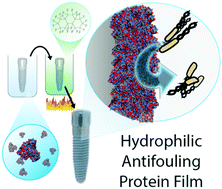当前位置:
X-MOL 学术
›
Mater. Horiz.
›
论文详情
Our official English website, www.x-mol.net, welcomes your feedback! (Note: you will need to create a separate account there.)
Translation of protein charge and hydrophilicity to materials surface properties using thermal treatment in fluorous media†
Materials Horizons ( IF 13.3 ) Pub Date : 2018-01-16 00:00:00 , DOI: 10.1039/c7mh00933j Li-Sheng Wang 1, 2, 3, 4 , Sanjana Gopalakrishnan 1, 2, 3, 4 , Yi-Wei Lee 1, 2, 3, 4 , Jiaxin Zhu 2, 3, 4, 5 , Stephen S. Nonnenmann 2, 3, 4, 5 , Vincent M. Rotello 1, 2, 3, 4
Materials Horizons ( IF 13.3 ) Pub Date : 2018-01-16 00:00:00 , DOI: 10.1039/c7mh00933j Li-Sheng Wang 1, 2, 3, 4 , Sanjana Gopalakrishnan 1, 2, 3, 4 , Yi-Wei Lee 1, 2, 3, 4 , Jiaxin Zhu 2, 3, 4, 5 , Stephen S. Nonnenmann 2, 3, 4, 5 , Vincent M. Rotello 1, 2, 3, 4
Affiliation

|
Protein-based materials provide an inherently biocompatible and sustainable platform for the generation of functional materials. Translating protein properties into protein films resistant to aqueous degradation is crucial for most applications such as tissue engineering and controlled drug delivery. Current methods to stabilize protein films use three main strategies: employing the relatively limited variety of naturally self-assembling proteins, using added cross-linkers or heat curing. While the cross-linking strategy generates functionally diverse structures, unreacted additives retained in cross-linked protein films can adversely affect their final behavior. Traditional heat curing results in hydrophobic surface and loss of protein inherent properties. We demonstrate here a scalable, additive-free, fluorous media assisted thermal treatment for the fabrication of stable, hydrophilic protein films. This approach is general in terms of protein building block, retaining much of their native structure and surface properties upon heating. We demonstrate the versatility of this strategy through fabrication of antifouling coatings on complex three-dimensional surfaces. The utility of these films as biomaterials is highlighted through the generation of highly biocompatible non-fouling surfaces and regulation of cellular adhesion through choice of protein precursor.
中文翻译:

在氟介质中进行热处理,将蛋白质电荷和亲水性转化为材料的表面性能†
基于蛋白质的材料为生成功能性材料提供了固有的生物相容性和可持续性平台。对于大多数应用(例如组织工程和受控的药物输送)而言,将蛋白质的特性转化为抗水降解的蛋白质膜至关重要。当前稳定蛋白质膜的方法使用三种主要策略:采用相对有限的多种自然自组装蛋白,使用添加的交联剂或加热固化。尽管交联策略生成功能多样的结构,但保留在交联蛋白膜中的未反应添加剂会不利地影响其最终行为。传统的热固化导致疏水表面和蛋白质固有性质的损失。我们在这里展示了一种可扩展的,无添加剂的 氟介质辅助热处理可制备稳定的亲水性蛋白膜。就蛋白质构件而言,这种方法是通用的,在加热时保留了它们的许多天然结构和表面特性。通过在复杂的三维表面上制造防污涂料,我们证明了该策略的多功能性。这些膜作为生物材料的实用性通过产生高度生物相容性的防污表面以及通过选择蛋白质前体来调节细胞粘附而得到强调。通过在复杂的三维表面上制造防污涂料,我们证明了该策略的多功能性。这些膜作为生物材料的实用性通过产生高度生物相容性的防污表面以及通过选择蛋白质前体来调节细胞粘附而得到强调。通过在复杂的三维表面上制造防污涂料,我们证明了该策略的多功能性。这些膜作为生物材料的实用性通过产生高度生物相容性的防污表面以及通过选择蛋白质前体来调节细胞粘附而得到强调。
更新日期:2018-01-16
中文翻译:

在氟介质中进行热处理,将蛋白质电荷和亲水性转化为材料的表面性能†
基于蛋白质的材料为生成功能性材料提供了固有的生物相容性和可持续性平台。对于大多数应用(例如组织工程和受控的药物输送)而言,将蛋白质的特性转化为抗水降解的蛋白质膜至关重要。当前稳定蛋白质膜的方法使用三种主要策略:采用相对有限的多种自然自组装蛋白,使用添加的交联剂或加热固化。尽管交联策略生成功能多样的结构,但保留在交联蛋白膜中的未反应添加剂会不利地影响其最终行为。传统的热固化导致疏水表面和蛋白质固有性质的损失。我们在这里展示了一种可扩展的,无添加剂的 氟介质辅助热处理可制备稳定的亲水性蛋白膜。就蛋白质构件而言,这种方法是通用的,在加热时保留了它们的许多天然结构和表面特性。通过在复杂的三维表面上制造防污涂料,我们证明了该策略的多功能性。这些膜作为生物材料的实用性通过产生高度生物相容性的防污表面以及通过选择蛋白质前体来调节细胞粘附而得到强调。通过在复杂的三维表面上制造防污涂料,我们证明了该策略的多功能性。这些膜作为生物材料的实用性通过产生高度生物相容性的防污表面以及通过选择蛋白质前体来调节细胞粘附而得到强调。通过在复杂的三维表面上制造防污涂料,我们证明了该策略的多功能性。这些膜作为生物材料的实用性通过产生高度生物相容性的防污表面以及通过选择蛋白质前体来调节细胞粘附而得到强调。


























 京公网安备 11010802027423号
京公网安备 11010802027423号